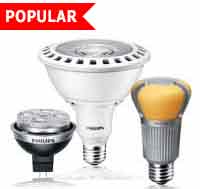LEDs: The Future of Lighting is Here
So, what does the little indicator light on your cell phone, a street light, an exit sign, and the common household light bulb have in common? If your answer is that light emitting diode (LED) technology can power all these things, then you're pretty bright.LEDs are a form of solid state lighting. Once the new kid on the block, LEDs have emerged as one of today's most energy-efficient and rapidly growing technologies. There are a wide variety of LED products available in the market, with the technology found in automobiles, computers, televisions, recessed downlights in the kitchen, flashlights, and holiday lights. LEDs are different than other types of lighting in that they last longer, are more durable, and save more energy and money. They also emit almost no heat. By comparison, inefficient incandescent lighting gives off 90% of their energy as heat.
In comparing energy-efficient light bulbs with incandescent bulbs, if you pay $8 to light a space in your home with a traditional bulb, you would pay about $2 to light the safe space with an LED. ENERGY STAR-qualified LEDs use only 20%–25% of the energy and last up to 25 times longer than the traditional incandescent bulbs they replace. While LED light bulbs are more expensive at this stage, as with other electronics, prices are coming down as more products enter the market.
In the outdoor lighting space, LEDs are impacting the sustainability initiatives of corporations and municipalities. WalMart now uses LED technology to meet updated DOE specifications for high-efficiency parking lot lighting, and is upgrading more than 250 existing lots. The company reports energy savings of 58% compared with ASHRAE Standard 90.1-2010, a widely used commercial building code. In comparing the performance of LED roadway lighting with high-pressure sodium (HPS) lighting in New York City, LEDs showed energy savings from 26 to 57%. Other major organizations, such as Lowe's, MGM Resorts International, and the U.S. General Services Administration are also considering upgrading their lighting to cut costs, reduce energy use, and increase their competitiveness.
As the adoption of LEDs grows, their energy saving potential can be enormous for the nation. According to a recent DOE report, by 2030, energy savings from LEDs can be up to 300 terawatt-hours, or the equivalent annual energy output of about 50, 1,000 megawatt power plants. At today's energy prices, this equates to approximately $30 billion in savings. These energy savings would also reduce greenhouse gas emissions by 210 million metric tons of carbon, and decrease the electricity consumption equivalent to powering 24 million homes.
Source: ECN

















Comments